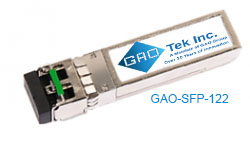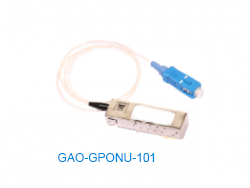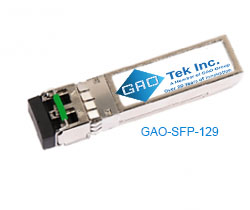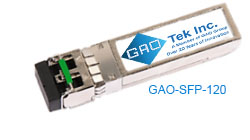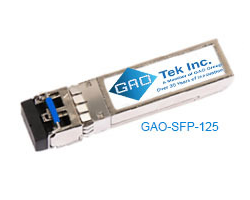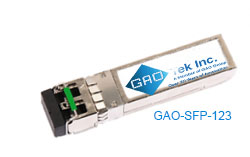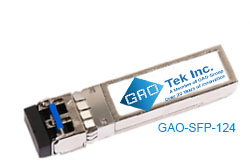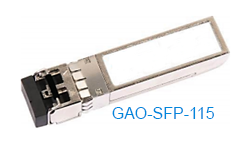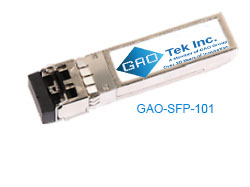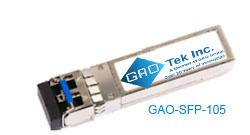Description
Overview:
This 1.25Gb/s 1310nm SFP (Small form-factor pluggable) Transceiver is used with Single-mode optical fiber to reach up to 24.85 miles (40km) transmission distance. It also has a DFB (Distributed Feedback) type transmitter, PIN type receiver, an LD (Laser Driver), a limiting amplifier and digital diagnostic monitor. This SFP Transceiver is a Class 1 laser safety product which complies with US FDA regulations, SFP MSA, SFF-8472 and RoHS standards.
Key Features:
- Up to 24.85 miles (40km) transmission distance.
- 1310nm DFB transmitter and PIN Photo-detector.
- Unique enhanced digital diagnostic monitoring interface.
- Up to 1.25Gb/s data links.
- Duplex LC/UPC type pluggable optical interface.
- Hot-pluggable SFP footprint.
- Metal enclosure, for lower EMI.
- Single +3.3V power supply
- Compliant with SFF-8472
- Low power dissipation
- Commercial case operating temperature range: 32°F to 158°F (0°C to +70°C)
- Extended case operating temperature range: 14°F to 176°F (-10°C to +80°C)
- Industrial case operating temperature range: -40°F to 185°F (-40°C to +85°C)
Technical Specifications:
| Protocol | 2-Wire Serial communication Protocol | |
| Working Range | Up to 24.85 miles (40km) | |
| Memory | 256-byte memory map in EEPROM | |
| Standards | SFF-8472 and SFP MSA.
Class 1 laser safety with IEEE802.3 z RoHS compliant. |
|
| Data rate | 1.25Gb/s | |
| Wavelength | 1310nm | |
| Fiber Optic Cable | 9/125µm Single-mode | |
| Transmitter | DFB | |
| Receiver | PIN | |
| Connector | LC | |
| Digital Diagnostics Monitoring | Enabled | |
| Transmitter output optical Power | -5 dBm to 0 dBm | |
| Receiver Sensitivity | -24 dBm | |
| Receiver Input Saturation Power | -1 dBm | |
| Supply Voltage | 3.3V | |
| Transmitter Differential Line Input Impedance | 100Ω | |
| Dimensions | 2.3in x 0.54in x 0.33in (L 58.4mm x W13.7mm x H 8.5mm) | |
| Relative Humidity | 5% to 95% Non-condensing
5% to 70% (Recommended) |
|
| Storage Temperature | -40 °F to 185 °F (-40°C to 85°C) | |
|
Case Operating Temperature |
Commercial | 32°F to 158°F (0°C to +70°C) |
| Extended | 14°F to 176°F (-10°C to +80°C) | |
| Industrial | -40°F to 185°F (-40°C to +85°C) | |
Additional Information:
Applications
Ideal to be used on applications such as
- Router/Server Interface
- Other Optical Links
- Gigabit Ethernet
- Switched Backplane Applications
- Switch to Switch Interface
Ordering Information:
| Product ID | Data rate(GB/s) | Media | Wavelength | Transmission Distance | Temperature Range | Supply Current |
| GAO-SFP-131
|
1.25 | Single-mode fiber | 1310nm | 1.24 miles (≤2km) | Commercial
32°F to 158°F (0°C to +70°C) |
280 mA |
| GAO-SFP-131A
|
1.25 | Single-mode fiber | 1310nm | 1.24 miles (≤2km) | Extended
14°F to 176°F (-10°C to +80°C)
|
280 mA |
| GAO-SFP-131B
|
1.25 | Single-mode fiber | 1310nm | 1.24 miles (≤2km) | Industrial
-40°F to 185°F (-40°C to +85°C)
|
280 mA |
Digital Diagnostics Functions:
- GAOTek GAO-SFP-131 series transceivers support the 2-wire serial communication protocol as defined in the SFP MSA1. It is very closely related to the E2PROM defined in the GBIC standard, with the same electrical specifications.
- Additionally, GAOTek SFP Transceivers provide a unique enhanced digital diagnostic monitoring interface which allows real-time access to device operating parameters such as transmitter optical power, receiver optical power, transceiver temperature, transceiver supply voltage and laser bias current. It defines an alarm system and warning flags, which alerts the end users when particular operating parameters are outside of a factory set normal range.
- Standard SFP Serial id provides access to identification information that describes the transceiver’s capabilities, standard interfaces, manufacturer and other information.
- SFP MSA defines a 256-byte memory map in EEPROM that is accessible over a 2 wire serial interface at the 8 bit address 1010000X (A0h). The interface is identical to, and is thus fully backward compatible with both the GBIC Specification and the SFP Multi Source Agreement.
- The operating and diagnostics information is monitored and reported by a Digital Diagnostics Transceiver Controller (DDTC) inside the transceiver, which is accessed through a 2-wire serial interface. The memories are organized as a series of 8-bit data words that can be addressed individually or sequentially.
- Digital diagnostics for the GAO-SFP-131 transceivers are internally calibrated by default.
Electrical Interface Characteristics:
| Parameter | Symbol | Min | Typ. | Max | Unit | Note |
| Transmitter | ||||||
| Total Supply Current | ICC | A | mA | 1 | ||
| Transmitter Disable Input-High | VDISH | 2 | Vcc+0.3 | V | ||
| Transmitter Disable Input-Low | VDISL | 0 | 0.8 | V | ||
| Transmitter Fault Input-High | VTxFH | 2 | Vcc+0.3 | V | ||
| Transmitter Fault Input-Low | VTxFL | 0 | 0.8 | V | ||
| Receiver | ||||||
| Total Supply Current | Icc | B | mA | 1 | ||
| LOSS Output Voltage-High | VLOSH | 2 | Vcc+0.3 | V |
LVTTL |
|
| LOSS Output Voltage-Low | VLOSL | 0 | 0.8 | V | ||
Note:
- A (TX) + B (RX) = 280mA (Not include termination circuit)
Optical Characteristics:
Specification of Transmitter:
| Parameter | Symbol | Min | Type | Max | Unit | Note |
| Average Output Power | POUT | -5 | 0 | dBm | ||
| Center Wavelength | λC | 1270 | 1310 | 1360 | nm | FP Laser |
| Side Mode Suppression Ratio | SMSR | 30 | dB | |||
| Spectrum Bandwidth(RMS) | σ | 1 | nm | |||
| Optical Extinction Ratio | ER | 9 | dB | |||
| Transmitter OFF Output Power | POff | -45 | dBm | |||
| Jitter P-P | tJ | 0.1 | UI | 1 | ||
| Output Eye Mask | Compliant with IEEE802.3 z (class 1 laser safety) | 2 | ||||
| Differential Line Input Impedance | RIN | 90 | 100 | 110 | Ohm | |
Notes:
- Measured at 2^7-1 NRZ PRBS pattern
- Transmitter eye mask definition
Specification of Receiver:
| Parameter | Symbol | Min | Type | Max | Unit | Note |
| Receiver Sensitivity | PIN | -24 | dBm | 1 | ||
| Input Optical Wavelength | λIN | 1270 | 1610 | nm | PIN-TIA | |
| Input Saturation Power (Overload) | Psat | -1 | dBm | |||
| LOS Assert | PA | -38 | dBm | |||
| LOS De -Assert | PD | -25 | dBm | 2 | ||
| LOS Hysteresis | PA – PD | 0.5 | 2 | 6 | dB |
Notes:
- Measured with Light source 1310nm, ER=9dB; BER =10 -12 @PRBS=27-1
- When LOS de-asserted, the RX data+/- output is signal output.
Pin out of Connector Block on Host Board:

PIN Descriptions:
| Pin | Symbol | Name/Description | Note |
| 1 | VEET | Transmitter Ground (Common with Receiver Ground) | 1 |
| 2 | TFault | Transmitter Fault | |
| 3 | TDis | Transmitter Disable. | 2 |
| 4 | MOD_DEF(2) | Module Definition 2. Data line for Serial ID. | 3 |
| 5 | MOD_DEF(1) | Module Definition 1. Clock line for Serial ID. | 3 |
| 6 | MOD_DEF(0) | Module Definition 0. Grounded within the module. | 3 |
| 7 | Rate Select | No connection required | 4 |
| 8 | LOS | Loss of Signal indication. Logic 0 indicates normal operation | 5 |
| 9 | VEER | Receiver Ground (Common with Transmitter Ground) | 1 |
| 10 | VEER | Receiver Ground (Common with Transmitter Ground) | 1 |
| 11 | VEER | Receiver Ground (Common with Transmitter Ground) | 1 |
| 12 | RD- | Receiver Inverted DATA out. AC coupled | |
| 13 | RD+ | Receiver Non-inverted DATA out. AC coupled | |
| 14 | VEER | Receiver Ground (Common with transmitter Ground) | 1 |
| 15 | VCCR | Receiver power Supply | |
| 16 | VCCT | Transmitter Power supply | |
| 17 | VEET | Transmitter Ground (Common with receiver Ground) | 1 |
| 18 | TD+ | Transmitter Non-Inverted DATA in. AC Coupled. | |
| 19 | TD- | Transmitter Inverted DATA in.AC Coupled. | |
| 20 | VEET | Transmitter Ground (Common with Receiver Ground) | 1 |
Notes:
- Circuit ground is internally isolated from ground.
- Laser output disabled when it is open or TDis > 2.0V, enabled on TDis < 0.8V.
- Should be pulled up with 4.7kΩ to 10kΩ on host board to a voltage between 2.0V and 3.6V.MOD_DEF (0) pulls the line low to indicate the module is plugged in.
- This is an optional input used to control the receiver bandwidth for compatibility with multiple data rates (most likely Fiber Channel 1x and 2x Rates).If implemented, the input will be internally pulled down with > 30kΩ resistor. The input states are:
- Low (0 – 0.8V) : Reduced Bandwidth
- (>0.8, < 2.0V) : Undefined
- High (2.0 – 3.465V) : Full Bandwidth
- Open : Reduced Bandwidth
- Loss of signal is open collector output.
- It should be pulled up with 4.7 kΩ to 10 kΩ on host board to a voltage between 2.0V and 3.6V.
- Logic 0 indicates normal operation.
- Logic 1 indicates loss of signal.
Mechanical Dimensions:

Recommend Circuit Schematic:

Regulatory Compliance:
| Feature | Reference | Performance |
| Laser Eye Safety | FDA 21CFR 1040.10, 1040.11 IEC/EN 60825-1,2 | Class 1 laser product |
| Component Recognition | IEC/EN 60950, UL | Compatible with standards |
| ROHS | 2002/95/EC | Compatible with standards |
| Electrostatic discharge(ESD) | IEC/EN 61000-4-2 | Compatible with standards |
| EMC | EN61000-3 | Compatible with standards |
| Electromagnetic Interference(EMI) | FCC Part 15 Class B EN 55022 Class B (CISPR 22A) | Compatible with standards |


